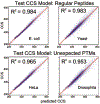Collision cross section measurement and prediction methods in omics
- PMID: 37620034
- PMCID: PMC10530098
- DOI: 10.1002/jms.4973
Collision cross section measurement and prediction methods in omics
Abstract
Omics studies such as metabolomics, lipidomics, and proteomics have become important for understanding the mechanisms in living organisms. However, the compounds detected are structurally different and contain isomers, with each structure or isomer leading to a different result in terms of the role they play in the cell or tissue in the organism. Therefore, it is important to detect, characterize, and elucidate the structures of these compounds. Liquid chromatography and mass spectrometry have been utilized for decades in the structure elucidation of key compounds. While prediction models of parameters (such as retention time and fragmentation pattern) have also been developed for these separation techniques, they have some limitations. Moreover, ion mobility has become one of the most promising techniques to give a fingerprint to these compounds by determining their collision cross section (CCS) values, which reflect their shape and size. Obtaining accurate CCS enables its use as a filter for potential analyte structures. These CCS values can be measured experimentally using calibrant-independent and calibrant-dependent approaches. Identification of compounds based on experimental CCS values in untargeted analysis typically requires CCS references from standards, which are currently limited and, if available, would require a large amount of time for experimental measurements. Therefore, researchers use theoretical tools to predict CCS values for untargeted and targeted analysis. In this review, an overview of the different methods for the experimental and theoretical estimation of CCS values is given where theoretical prediction tools include computational and machine modeling type approaches. Moreover, the limitations of the current experimental and theoretical approaches and their potential mitigation methods were discussed.
Keywords: CCS; computational methods; ion mobility; machine learning; omics.
© 2023 John Wiley & Sons Ltd.
Figures





References
-
- Abdel-Aziz MI; Neerincx AH; Vijverberg SJ; Kraneveld AD; Maitland-van der Zee AH In Omics for the future in asthma, Seminars in immunopathology, Springer: 2020; pp 111–126. - PubMed
-
- Cevallos-Cevallos JM; Reyes-De-Corcuera JI; Etxeberria E; Danyluk MD; Rodrick GE, Metabolomic analysis in food science: a review. Trends in Food Science & Technology 2009, 20 (11–12), 557–566.
-
- Hosseinkhani S; Aazami H; Hashemi E; Dehghanbanadaki H; Adibi-Motlagh B; Razi F, The trend in application of omics in type 2 diabetes researches; A bibliometric study. Diabetes & Metabolic Syndrome: Clinical Research & Reviews 2021, 15 (5), 102250. - PubMed
-
- Nam S-E; Bae D-Y; Ki J-S; Ahn C-Y; Rhee J-S, The importance of multi-omics approaches for the health assessment of freshwater ecosystems. Molecular & Cellular Toxicology 2023, 19 (1), 3–11.
Publication types
MeSH terms
Grants and funding
LinkOut - more resources
Full Text Sources

